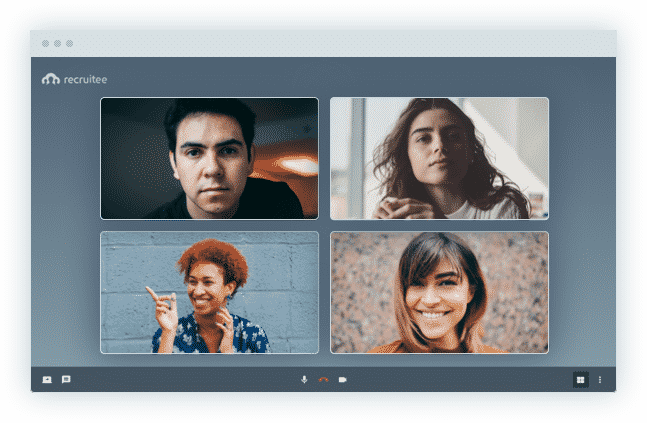Interviews can be a critical turning point in any recruitment process. They’re often the moment where the recruiter and the hiring team get to delve into a candidates’ skills and experience, face-to-face. But in a modern recruiting environment, the face-to-face element is not always possible. Cue video interviewing.
Despite the functionality and convenience of video interviewing, not everyone is a fan. We all know the horrors of laggy connectivity, video calls that drop out of nowhere, or audio that breaks in and out. Sitting in an empty room, talking to your screen, can already feel forced and awkward without the technical difficulties.
Recruiters often strive to make candidates as comfortable as possible in an interview. This way you can really get to know them. But it’s tough to offer a candidate a cup of coffee or tea when they’re sitting at their computer in another city or country.
So what are the rules of thumb when it comes to conducting a video interview? How should you prepare in order to make the most out of your interviews?
Pros and cons of video interviewing
Online interviews are not for everyone, but they’re also not for every situation. They have their ups and downs, which are good to know before you go ahead and set your heart on one.
Pros of video interviews
- Convenient: In an increasingly global workforce, many recruiters will eventually turn to source candidates from outside of their city, if not country. Online video interviews can help facilitate the interviewing process.
- Speeds up your time to hire: With interviews more accessible, using online video interview technology will inevitably speed up your time to hire. No more waiting for candidates to have free time to come into the office. With video, they can block out only the necessary time for the interview, rather than having to factor in travel time.
- Opens up talent markets: If you implement a video interview strategy, you may also open up talent markets that were previously inaccessible. Often teams are not able to consider foreign talent as they cannot commit to bringing them over without properly getting to know their skills and experience. Video interviews, when well-organized, can help you get to know far-away candidates with little commitment.
Cons of video interviews
- Low commitment: Because candidates don’t experience the commitment of having to schedule an in-person meeting, they may wind up canceling last minute. This can be particularly troublesome with passive candidates.
- Technical difficulties: Everyone’s experienced a glitchy online video conversation at some point. Online interviews are no exception.
- Extra preparation: In addition to the normal preparation you should undertake for an in-person interview, you’ll also need to check that everything is working beforehand. If there are difficulties with the video or audio, it could mean extra time sunk into prep.
How to set up a smooth video interview
Despite the difficulties around online interviews, video recruiting (and interviewing!) is becoming increasingly popular because of the convenience. As this trend persists, running a smooth online job interview should be a skill in any modern recruiter’s arsenal. Follow these seven simple steps to make the most of your screentime with your candidates.
1. Send out the invitation
After you’ve shortlisted candidates for the role, you’ll want to invite them for their very first video interview. Inviting candidates should be easy and preferably done from within your ATS to simplify the process.
Make sure they have the following information:
- Date and time of the interview.
- The name and title of their interviewer. Preferably with a link to their LinkedIn profile.
- Instructions on how to join the call. This should include an automatically generated link to the calls and any further details like if a download is required, what kind of browser they should use, and how to share their screen if necessary.
- A protocol on what to do if the connection cuts. Expect the best, but prepare for the worst. Let the candidate know that you’ll call back first or fall back on their phone number should something go amiss in the communication.
- Advice on video interviews. Not all candidates will comfortable with an online interview. Offering some general advice like make sure to join early and find a quiet, light spot may help alleviate the stress for first-timers. Make sure they avoid some unintended disruptions like this one.
2. Book the right setting
Even though the interview will take place online, the physical setting is still important when video recruiting. If you’re in a bigger office, ensure that the intended room is booked for your interview and that there are no disruptions.
Small tip: Ensure that you’re facing any direct light, rather than having the light behind you. For instance, you should face a window rather than having one behind you. This will make sure that you’re easy to see rather than shaded out by backlighting.
3. Prepare set up
The day has come! It’s time to prepare your video interviewing set up.
- Check your headphones. Even if you have a room booked that’s quiet, using headphones with a small speaker can help improve the sound quality for the candidate. If you use the internal microphone and speaker, the candidate might experience an echo or poor sound quality.
- Double check your internet connection. If the connection is not stable, you may want to opt to use a personal hotspot if the connection there is more stable.
- Test the audio and video. Test that your video interviewing software is registering your video and audio source. You may have to switch to your headphones in the settings to make sure it uses that source and not the internal speakers.
- Look the part. Just because you’re not meeting in person, doesn’t mean you shouldn’t treat it like an in-office meeting. Make sure you’re dressed as you normally would for a candidate meeting, sitting upright, and paying close attention to the screen. This will give the candidate the feeling of a serious interview.
- Open a window for notes. Just like in-person interviews, you’ll need to take a few notes, especially if you’re using structured interviews. Make sure that this is accessible next to the online interview window.

5. Be the first to show up
Candidates may already be nervous for an interview, let alone an online one where things might not go to plan. When they start the call and the screen is blank waiting for the recruiter, they may be left wondering if they got something wrong or if the connection is working.
Put your candidates’ minds at ease by joining the virtual meeting first.
6. Ease in with a few chit-chatty questions
Usually, when a candidate comes in for an interview, you might show them around the office first or ask them a few casual questions about their journey while grabbing a cup of coffee or tea. This can help break the ice.
When video interviewing you won’t have the natural flow of greeting them and introducing them to the office. But make sure you build in a few pre-interview questions to ease the tension. These questions can help the candidate open up if they’re nervous.
Take a look at their CV to consider a few video interview questions that might break the ice. For example, you might ask them about their university or what they studied. Or if they were recently on holiday you might ask them where they went. Keep it light and casual.
7. Follow up with next steps
Once you’ve completed your online interview, send a quick email to the candidate with any agreed next steps. This should be true for both in person and video interviews, but it’s particularly important to do when you’ve not met the candidate in person. This will help manage expectations, which is a fundamental ingredient to promote a great candidate experience.

Recruiter’s tips to hire from a video interview
Once you’ve gotten the hang of video interviewing, they can easily become a powerful tool in your recruiting toolbox. So powerful in fact, that you may be able to make hiring decisions and offers having never met a candidate in person. Sounds crazy, but there are many recruiters out there making it work for their teams.
Rebecca Clarke, Recruitee’s Talent Acquisition Manager, is one recruiter who’s making the most of video interviewing. With a growing number of applications coming from outside of the Netherlands, it’s not always possible to meet candidates face-to-face. Rebecca shares some of her best practices on successfully hiring from video interviews.
Conducting an online interview
Without the face-to-face contact, connecting with candidates will be your first challenge to tackle, “If you are hiring solely from video or remote interviews then make time for a relaxed chat to really get to know the person.”
Once you’re off to a good start, the bulk of the interview changes slightly when online, “Give them time when asking situational questions they may feel rushed. You do not have to fill the silence. Take note of the small unspoken cues and whether they respond to social cues. It may be slightly more difficult, but focus us on the tone, expressions, eye contact etc.”
“Ask yourself ‘Are they listening? Are they engaged? Are they really passionate about what they’re talking about?’ Reflecting on these things in a more focused way will help you better assess a candidate on video.”
Like with any interview, there are a few things you may want to look out for: “Red flags: people who have not researched the role. They’re clearly not committed, which is a bigger deal when relocating or interviewing in a low commitment environment like video.”
Relevant: 5 ways video interviewing can tank your candidate experience
Stick to your interviewing basics
Rebecca shares her most important piece of advice when it comes to conducting a video interview, “Stick to your process but adapt it. It’s a mistake to skip the skills assessment or test round. Here at Recruitee, we run a full trial morning with an assignment and presentation. For those that we’re looking to hire only through video interviews, the only difference is that the assessment is done virtually.”
If you regularly run job trials or conduct candidate assessments, don’t let the virtual nature of the process alter this vital step.
Shore up a stellar candidate experience
The candidate experience is always important. But in the absence of an in-person connection, it should have a special focus. “You can’t shake their hand or make them feel welcome in the normal way, so you have to ensure that it’s done through keeping them up to date and offering the full candidate experience,” Rebecca shares.
For hires made through video interviews, Rebecca stresses that the in-person meeting is still important, “Relocating is a big deal. Set up a meeting with them when they do arrive in the country or city and make them feel welcome. Definitely try to meet them before their first day!”
Taking on the video interviewing trend
Video recruiting may take some getting used to, but practice makes perfect. As the talent shortage intensifies in certain key areas, online interviews will become an increasingly valuable tool. Chose a video interviewing tool that’s reliable and encourages connections rather than stress, preferably one that works within or in conjunction with your ATS. With some best practices, advice, and the right tool, you’ll be well on your way to mastering the art of the video interview!









